|
|


ADVERTISEMENT
Buy Your own advertising
spaces!
.
Download Adobe Acrobat Reader to open [PDF] files.
Recent Visitors
World Expo Shanghai 2010 Pavilions - Some Favourites
2010. 15 March
This list is by no means a complete list of pavilions or “good” pavilions. Rather, it is a list of the pavilions that stuck out to me in my random browsing of the Internet and the official World Expo Shanghai 2010 Web site.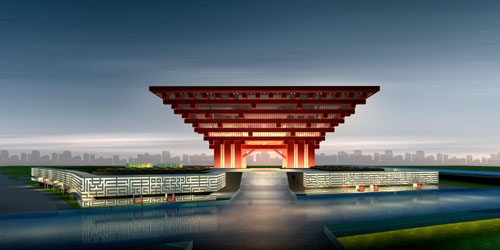 by Ryan McLaughlin
by Ryan McLaughlin
(lostlaowai.com)
In less than two months the 2010 Shanghai World Expo will start its six-month run. As I’m slowly catching Expo Fever, I thought I’d run through a few of my favourite pavilions, comparing and contrasting what the official word on the structure is with my amateur thoughts and opinions.
They Say: The China Pavilion is designed with the concept of “Oriental Crown.” The traditional Chinese wooden structure element, Dougong brackets, is introduced. Its main colour is “Gugong (Forbidden City) Red” which represents the taste and spirit of Chinese culture. China’s achievements in urban development from ancient to modern times will be the core theme of the pavilion.
I Say: It looks awesome, truly. I love the traditional style and imposing design — two things that describe China well. Its China’s expo, and understatement is not needed nor expected in my opinion. I think its top-down concept is cool, and with the amount of pressure on the country to have a good showing, the pavilion is sure to be a highlight of the event.
Hong Kong

They Say: It will be a three-story 600-square-meter metallic-colored structure beside the 20,000-square-meter China Pavilion, known as the “Crown of the East.” The second floor of the pavilion will be transparent. The pavilion will symbolize the imagination and creativity of Hong Kong people. The pavilion will feature an indoor wetland park on the third floor replicating the Hong Kong Wetland Park in downtown Tin Shui Wai, New Territories, which opened in 2006. Famous Hong Kong pop stars will be around the pavilion during Expo and visitors will able to talk and take photos with them.
I Say: Next to the main China pavilion I can’t help but feel this looks a bit like a trailer. Still, the modern look works well in contrast to the more traditionally-flavoured “Crown of the East” and mirrors the divides between HK and the mainland.
Macau

They Say: It has been designed to look like a rabbit lantern sitting under China’s national pavilion. The Macau pavilion will be covered by a double-layer glass membrane and fluorescent screens. Kinetic balloons will form the head and tail of the “rabbit.” In Chinese mythology, the jade rabbit welcomes visitors to a magical fairyland.
I Say: I can’t believe there wasn’t at least one guy in the planning committee that didn’t stop and go, “Wait, wait, wait. It’s a fucking bunny. Seriously?” In the pros column, maybe they’ll give out free chocolate eggs inside.
United Kingdom

They Say: The 20-meter-high cube-like Seed Cathedral will be covered by 60,000 slim, transparent acrylic rods, which will quiver in the breeze. Each 7-meter-long rod contains a certain type of seed, a call from the UK to protect natural species and the future of mankind.
I Say: This, to me, is what the World Expo is all about — awesomely odd looking buildings that you would never build for any other reason but a World Expo. That it looks like a giant Koosh Ball makes it all the cooler.
Saudi Arabia
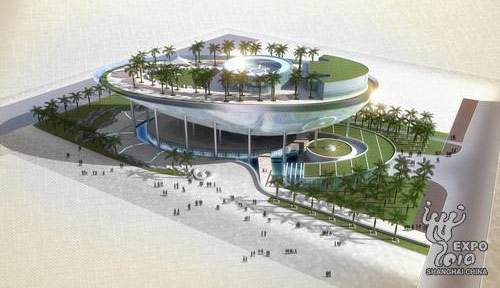
They Say: They will plant 150 date palms, which are common in the desert country, on the roof of their pavilion. The trees were transplanted to Zhejiang Province and will be replanted on the roof of Saudi Arabia Pavilion as soon as construction is finished. It may end up being the most expensive pavilion at World Expo 2010 as the Middle-East country said it has no budget limit. The pavilion is a combined effort of Chinese and Saudi designers. The pavilion has a “moon boat” shape and is surrounded by deserts and seas, just like Saudi Arabia. The pavilion’s main attraction will be a huge cinema screen. The 1,600 square-meter screen will be larger than any other cinema screen on earth.
I Say: I like the oasis feel. Disappointingly, but perhaps unsurprisingly, the pavilion seems more about showing off the country’s wealth than any sort of concerted effort to work towards the theme of the expo or relay its culture on a world stage.
Turkey
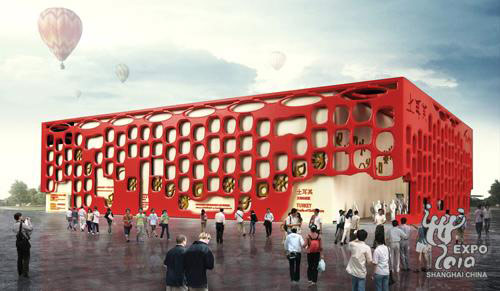
They Say: The main inspiration for the exterior of the 2,000-square-meter pavilion was derived from settlements called “Catalhoyuk” in Turkish, which were the center of advanced culture in the Neolithic period. The pavilion looks like an amazing red and beige box with an animal sculpture, inviting visitors to explore a maze of dreams. The first section of the pavilion will take visitors through a journey of time to learn about Turkey’s historical firsts. A map indicating the ancient sites of Turkey, the world’s first mirror and the world’s first man-built dam will be featured here.
I Say: It’s a bit goofy looking, but I like it. I also like that the country has worked hard at integrating its history and culture tightly with the theme of the expo.
Romania

They Say: It will take the shape of a green apple in its focus on a “green city” concept. The pavilion will cover 2,000 square meters and its apple shape and logo “Greenopolis” reflect the importance of healthy lifestyle, sustainable development and knowledge-based solutions for modern society, Romanian officials said.
I say: The “green apple” = “green city” thing is a bit of a stretch, and it is definitely in the same camp with Macau for taking nature in architecture a step too far. But it wins points for being unique. The unofficial Romanian slogan for the expo should be “at least we’re not a f’king bunny.”
Brazil

They Say: The nation will show off the cultural diversity of Brazilian cities, their dynamism and, of course, the ever-present football with the theme “Pulsing Cities: Feel the Life of Brazilian Cities.” The pavilion will highlight the transformation of Brazilian cities in search of urban solutions that result in sustainable development and wellbeing for citizens.
I Say: It sort of looks like a Rainforest Cafe crossed with a netbar, but I’ll visit it. The exterior doesn’t do much justice to the promising video displays inside. And there’s got to be at least a few visual references to Brazilian beaches, doesn’t there?
Denmark
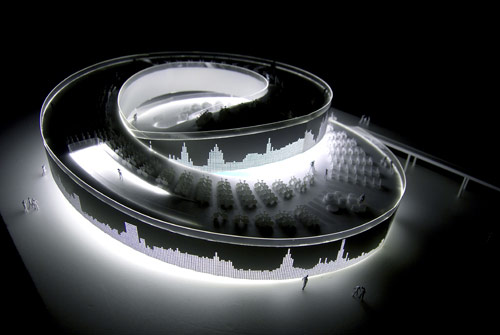
They Say: The pavilion, called “Welfairytales” – a blend of the words “welfare” and “fairy tales” – will feature a salt water pool filled with water from the Danish harbor. Thogersen said the harbor suffered industrial pollution 20 years ago, but had been purified and now local people even swim at the sea, which is a “good showcase of Denmark’s style of sustainability.” The pavilion will showcase a fairy tale world with the Little Mermaid, the country’s symbol, set to make her first visit to Shanghai in 2010. The Little Mermaid statue is one of Denmark’s major tourist attractions and sits on a rock in Copenhagen harbor. The winning team behind the design of the pavilion hopes to bring it to Shanghai.
I Say: That’s one cool looking danish. I’ve not heard of any other countries dismantling national treasures to bring to the expo, so extra points for that. Plus it’s said to contain 1,500 bikes that are presumably available for loan to visitors. Those wacky Danes and their bikes. Designboom has a good review of this rather rad pavilion.
Israel

They Say: The pavilion consists of three areas — Whispering Garden, Hall of Light and Hall of Innovations. The Whispering Garden is a green orchard that greets visitors as they enter the building. Some facilities will be installed to make the trees begin to “whisper” in both English and Chinese when visitors walk close to them. The hall of Light includes a 15-meter high screen, which will display films highlighting the country’s innovations and technological achievements. The Hall of Innovation is the centerpiece of the Israel Pavilion. A special audio-visual show will allow visitors to talk with Israeli children, scientists, doctors and inventors via hundreds of screens. These Israelis will introduce themselves and share their hopes for a better future.
I Say: This is Israel’s first World Expo pavilion, and they’ve done well. Looking at the structure, it just feels like buildings in the future could look like this. As my picks here reveal, I heavily favour the designs that feature smoother, flowing architecture over big block buildings — and I think the Israeli pavilion looks great in this regard.
Switzerland
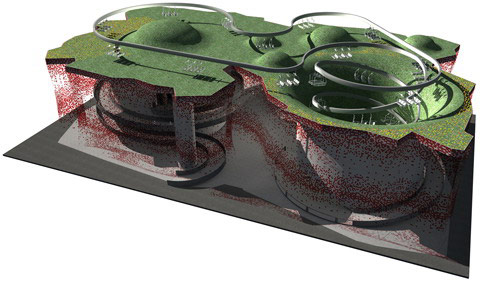
They Say: The Swiss Pavilion is inspired by the concept of balance, as embodied in the traditional Chinese concept of yin and yang, which is relevant to the sub-theme of the Expo “rural-urban interaction.” Rural and urban areas are complementary yet opposing, and the combination of the two ensures a balance between society and nature. A regular and healthy interaction between the rural and urban areas is a prerequisite for sustainable and harmonious development in ecological, economic and social aspects.
I Say: In contrast to the Chinese pavilion, which will focus on migration from China’s rural past to a more urbancentric future, I like how the Swiss pavilion is stating that the two can be blended. Though if some of the neighbourhoods I’ve lived in here in China are an indicator, the Chinese are way ahead in urban farming.
United Arab Emirates

They Say: The UAE pavilion is based on the form of a sand dune. The pavillion is a reference to this symbolic feature of the
desert landscape shared by each of the seven emirates. Like a sand dune, the pavillion appears rough and textured on the side that bears
the full force of the wind and smooth on the other side. The northern elevation is more porous to admit natural light, while the southern elevation has a solid facade, to minimise solar gain.
I Say: Pretty cool eco-friendly pavilion with a unique country-related design. And don’t believe the rumours, it definitely looks nothing like a vagina. Definitely.
Italy

They Say: Its design was inspired by the children’s game “pick-up sticks,” which is known as “Shanghai” in Italy. The rectangular pavilion will be laced with intersecting lines – representing pick-up sticks. The 3,600-square-meter structure comprises 20 functional modules of different shapes, bounded by the “sticks.” They represent Italy’s 20 regions. The modules can be assembled into smaller structures. After the Expo, the building will be disassembled and reconfigured.
I Say: I almost discounted this pavilion because, as I mentioned above, I really dislike big blocky looking buildings. The Italians have a way with things though and did well with their design. The frigin’ thing features translucent concrete, and that is way cool. Plus its cross-cultural “pick-up-sticks”/”Shanghai” tie-in is clever.
France
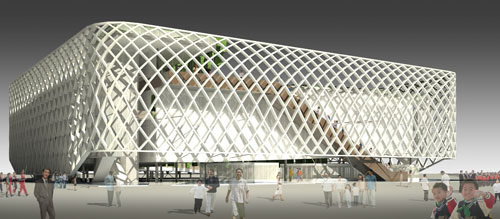
They Say: The final design, “the Sensual City,” selected from 49 candidates, presents a simple building with a big French-style garden inside. Surrounded by water, it appears to be floating.
I Say: I like the ultra-modern mesh look and large garden/green-space inside.
Germany

They Say: The 6,000-square-meter structure will be Germany’s largest at any Expo and will comprise three exhibition areas which will showcase German urban life and how the country’s design and products can help solve urbanization problems. The theme of the pavilion is “Balancity.” It will demonstrate the importance of balance between modernization and preservation, innovation and tradition, community and the individual, work and leisure, and between globalization and national identity. Pavilion architect Lennart Wiechell said the highlight of the pavilion will be a cone-shaped structure housing a revolving metal sphere, 3 meters in diameter and covered with 30,000 LEDs, which will be activated by the noise and movement of spectators.
I Say: I just really like the design. Unique angles and moving parts are cool. Overall the theme of balance is neat too. Curious to see what solutions the Germans have to the issues of balance — particularly the balance between work and leisure. Hopefully it doesn’t involve getting lobster tans in Speedos at the workplace.
Shanghai Automotive Industry Corp and General Motors
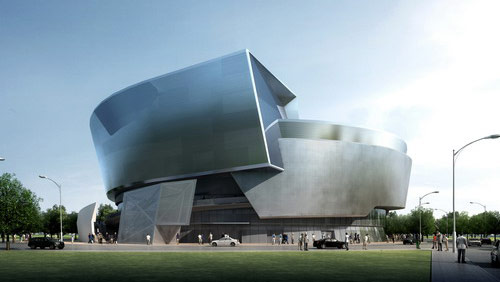
They Say: The 6,000-square-meter pavilion will explore the theme “The Road to the Future” with a vision of a safe, convenient and intelligent traffic system within 20 years. Visitors will see what vehicles might look like in 2030.
I Say: The company is making comparisons to its showing at the 1933 World Expo in which it touted the concept of a “freeway”. Ironically, North America’s over-dependence on automobiles, and shunning of mass-transit are perpendicular to the Shanghai Expo’s theme of “Better City, Better Life”. Hopefully the Road to the Future tackles this. Likely it will just be a showcase for some rad looking cars. Meh, that’s ok too.
ROK Joint-Corporate Pavilion

They Say: The ROK Joint-Corporate Pavilion is being built by 12 South Korean companies, including Samsung, E-mart and LG and the theme of the pavilion is “Green City, Green Life”. The 3,000-square-meter pavilion is a cube with spirals. The design is inspired by the skirts of a dancing ROK woman wearing traditional costume.
I Say: Feels like a pleasant and non-ostentatious design that suits the bank of the Huang Pu well.
Obviously Missing From The List
There are two pavilions that I’ve not included above because, well, they do nothing for me. However, I’d be remiss if I didn’t at least mention them.
USA
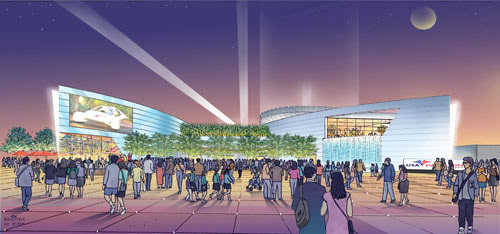
They Say: The USA Pavilion will showcase sustainability, teamwork, health, struggle and achievements.
I Say: Showcase teamwork and achievement? I mean, struggle, sure. But most of the other stuff is laughable. For an excellent rundown on the clusterfuck that went into the American pavilion, check out “A Sorry Spectacle: The uninspiring saga of the United States’ World Expo pavilion in Shanghai” by Adam Minter. As for the design itself, I’ve seen more inspired movie theatres.
Canada
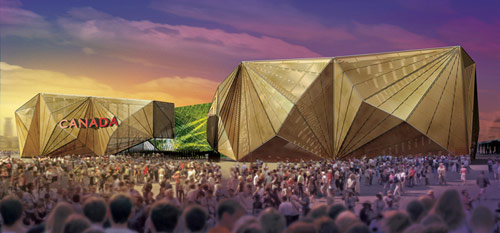
They Say: The Canada Pavilion, among the biggest at the site, will feature an exhibition themed “The Living City: Inclusive, Sustainable, Creative.” The pavilion is about the size of two-and-a-half NHL ice hockey rinks. The pavilion will be anchored by an open public place and surrounded by three large structures. The square will be a performing area, where visitors can watch the performances of Cirque du Soleil before checking out the pavilion.
I Say: It’s a given that this Canuck will be visiting his country’s pavilion, whether the design of it inspires him or not. I’ve never seen any of the incarnations of Cirque du Soleil and so that’s a possible bonus of attending, as is potentially catching a glimpse of Da Shan, or “Mr. Mark H. Rowswell“, as he’s officially known in the role of the Commissioner General for Canada at Expo 2010 in Shanghai (seriously, that’s the actual length of his title). There’s a lot of controversy in Canada over the pavilion, and its design having been awarded to a circus over an architect. I don’t think it’s that bad, but it’s also not anything we’ll be bragging about for decades to come.
Source: www.lostlaowai.com

